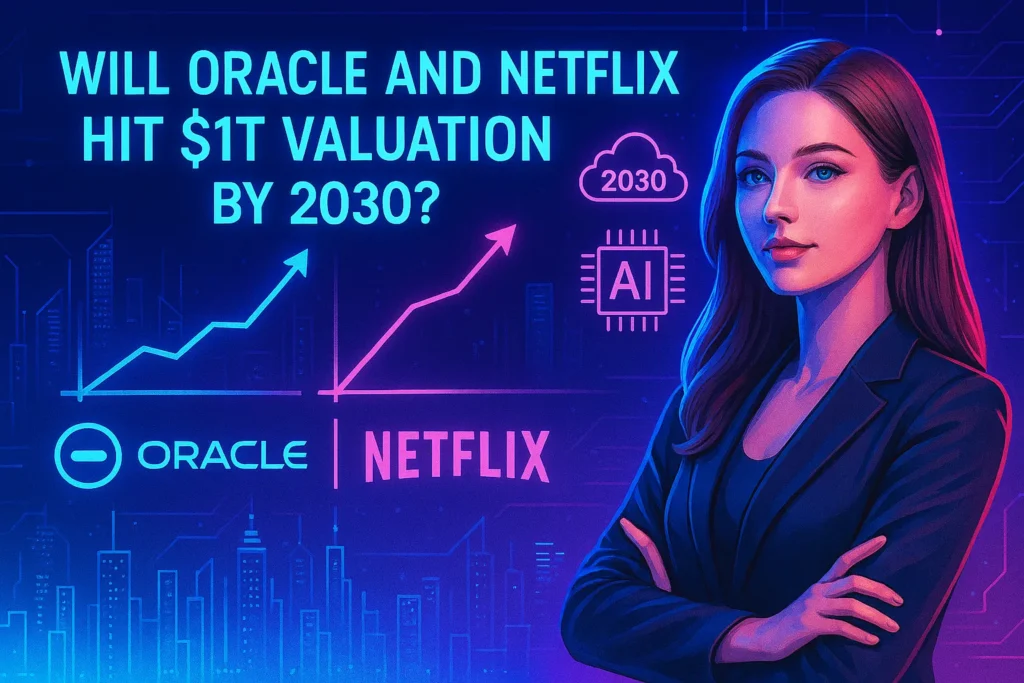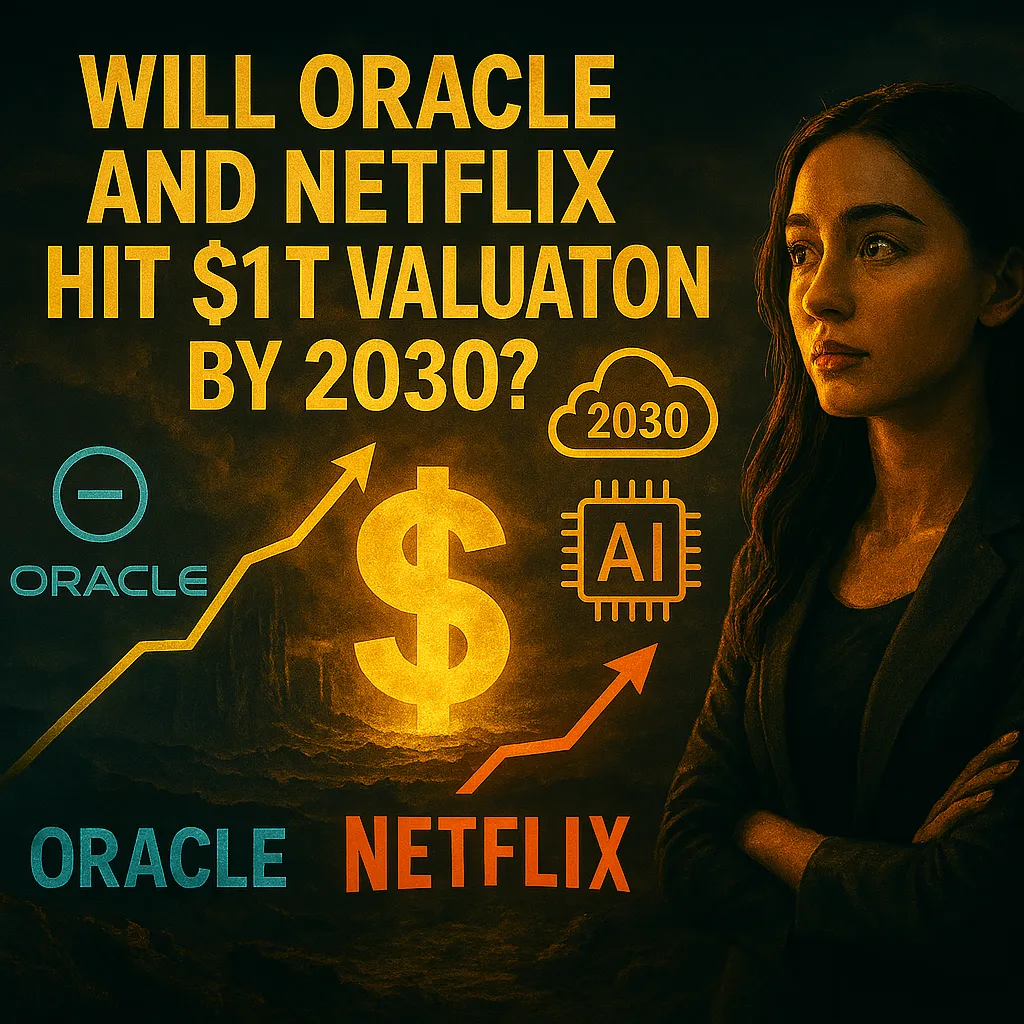Introduction
The phrase “Oracle and Netflix $1 trillion” captures one of the most exciting investment debates of the decade. Today, the trillion-dollar club in the S&P 500 is dominated by tech behemoths — Apple, Microsoft, Nvidia, Amazon, Alphabet, Meta, Tesla, Broadcom, and Berkshire Hathaway.
But investors are asking: Who will be next?
The spotlight is now on the Ten Titans, a group of the largest growth companies in the index. Among them, Oracle and Netflix are the strongest candidates to cross the trillion-dollar milestone by 2030.
While 2030 is just five years away, the idea of “fast forward seven years” gives us a long-term lens to evaluate whether Oracle and Netflix can realistically join the elite trillion-dollar club. Let’s break down their paths, challenges, and investor outlooks.

Oracle and Netflix $1 trillion: The trillion-dollar race
The trillion-dollar milestone was once unimaginable — Apple only became the first company to reach it in 2018. Fast forward to 2025, and nine corporations now hold this distinction, reshaping both the stock market and the global economy.
The Ten Titans — Nvidia, Microsoft, Apple, Amazon, Alphabet, Meta, Tesla, Broadcom, Oracle, and Netflix — represent the most influential players of modern capitalism. But only Oracle and Netflix are still outside the trillion-dollar club.
Will they get there by 2030?
💼 Ten Titans Overview: Who’s Already in the Club?
The Ten Titans represent the largest growth-focused companies by market capitalization. As of August 2025, nine have already crossed the $1 trillion threshold, while Oracle and Netflix are closing in.
✅ Ten Titans Market Cap Table (August 2025)
| Company | Sector | Approx. Market Cap (2025) |
|---|---|---|
| Microsoft (MSFT) | Cloud & Software | $3.2 trillion |
| Apple (AAPL) | Consumer Tech | $3.0 trillion |
| Amazon (AMZN) | E-commerce & Cloud | $1.9 trillion |
| Alphabet (GOOG/GOOGL) | Search & AI | $1.8 trillion |
| Nvidia (NVDA) | AI & Semiconductors | $1.7 trillion |
| Meta Platforms (META) | Social & VR | $1.2 trillion |
| Tesla (TSLA) | EV & Energy | $1.1 trillion |
| Broadcom (AVGO) | Infrastructure & Chips | $1.0 trillion |
| Berkshire Hathaway (BRK.A/B) | Diversified Holdings | $1.0 trillion |
| Oracle (ORCL) | Enterprise AI & Cloud | ~$660 billion |
| Netflix (NFLX) | Streaming & Media | ~$516 billion |
📌 Strategic Insight:
- The dominance of these companies reflects a concentration of innovation and capital in AI, cloud, and digital platforms.
- Oracle and Netflix are the only two yet to cross the $1 trillion mark, but both have clear strategic roadmaps to get there by 2030.

Oracle and Netflix $1 trillion: Oracle’s growth potential
Oracle’s evolution from legacy to leader
For decades, Oracle was viewed as a legacy enterprise software giant. But over the last five years, it has reinvented itself into a serious cloud and AI contender, with a market cap hovering around $660 billion.
Unlike Amazon, Microsoft, and Alphabet, which juggle consumer and enterprise businesses, Oracle is a pure-play enterprise solutions provider. This focus allows it to allocate resources directly toward cloud computing and AI infrastructure.
Oracle’s cloud and AI momentum
Oracle’s cloud growth has been outpacing some larger incumbents, largely due to its:
- Hybrid data center model
- Competitive pricing strategy
- Partnerships with rivals like AWS and Microsoft
Most importantly, Oracle has been pouring billions into AI-related capital expenditures (capex). It is positioning itself as the backbone for enterprise AI adoption — a market expected to grow massively in the next five years.
Oracle’s risks and challenges
But the path to $1 trillion isn’t risk-free:
- High debt load — Oracle’s balance sheet is leveraged.
- Negative free cash flow — due to heavy AI investment.
- Premium valuation — trading at 34.6x forward earnings.
If Oracle’s AI bets succeed, the payoff could be immense. But if growth doesn’t materialize, investors could face stagnation or downside.
My analysis: Oracle resembles Nvidia circa 2018 — ambitious, expensive, but with enormous potential. Execution will be everything.
Oracle and Netflix $1 trillion: Netflix’s big challenge
Netflix’s current position
Netflix currently holds a $516 billion market cap. To join the $1 trillion club by 2030, it needs to nearly double its valuation in just five years. That translates into a required 14.2% CAGR, well above the S&P 500’s historical 9–10%.
Netflix’s strategic roadmap
Netflix’s management has outlined bold goals for 2030:
- Double revenue to around $78 billion
- Triple operating income to $31 billion
- Expand margins to 40%
To achieve this, Netflix is diversifying its business model:
- Ad-supported tiers — tapping into a multi-billion-dollar digital advertising market.
- Gaming expansion — building a new entertainment vertical beyond streaming.
- Content efficiency — scaling back runaway spending while maintaining quality.
Netflix’s risks and competition
Netflix faces stiff competition from:
- Disney+
- Amazon Prime Video
- Warner Bros. Discovery
Unlike Oracle’s enterprise model, Netflix is consumer-driven, making it vulnerable to shifting tastes, content hits and misses, and global economic slowdowns.

Oracle and Netflix $1 trillion: Comparing the 2 paths
| Factors | Oracle | Netflix |
|---|---|---|
| Current Market Cap | $660B | $516B |
| Needed Growth | +51% | +94% |
| Growth Driver | Enterprise AI & Cloud | Streaming, Ads & Gaming |
| Risk Profile | Debt-heavy, AI execution risk | Consumer tastes, competition |
| Trillion-Dollar Odds | Strong if AI bets succeed | Tough, but achievable |
Key takeaway: Oracle has the shorter financial distance to cover but faces execution risks in AI. Netflix has the bigger climb but benefits from consumer brand loyalty.
Oracle and Netflix $1 trillion: Impact of the Ten Titans
The Ten Titans now control an outsized share of the S&P 500’s market cap, reshaping how the index behaves.
- Upside: Strong earnings from Titans can push the market to new highs.
- Downside: Weak earnings can accelerate broad sell-offs, as seen in April 2025.
Valuations are already stretched, meaning future gains must come from earnings growth, not just multiple expansion.
My analysis: Oracle and Netflix’s eventual entry into the $1 trillion club would further concentrate market influence — amplifying both potential rewards and risks for investors.
Oracle and Netflix $1 trillion: Investor outlook
Should investors buy into Oracle or Netflix today with 2030 in mind?
- Oracle: Best positioned for AI-driven enterprise growth. High reward but also high risk due to debt and heavy spending.
- Netflix: Global cultural powerhouse. A harder climb, but strong adaptability and diversification make it compelling.
For long-term investors, both represent growth stories with volatility. The key is patience and conviction.
Conclusion
The phrase “Oracle and Netflix $1 trillion” is no longer just speculation — it’s a plausible scenario for 2030.
- Oracle could become the infrastructure king of AI and cloud, provided its massive capex bets deliver results.
- Netflix could transform into a global entertainment and gaming empire, if it doubles revenue and expands margins.
Both companies face challenges, but both also represent the bold innovation required to achieve trillion-dollar valuations.
As we fast forward seven years, investors may witness Oracle and Netflix stand shoulder to shoulder with Apple, Microsoft, and Nvidia — shaping not only industries, but the future of the global economy.
FAQs
Q1: Can Oracle and Netflix really hit $1 trillion by 2030?
Yes, but through very different paths. Oracle must succeed in enterprise AI adoption, while Netflix must nearly double its value through diversification and margin growth.
Q2: Why is Oracle closer to $1 trillion?
Oracle’s current $660B valuation means it only needs ~51% growth. But execution risks in AI and high debt remain major challenges.
Q3: How can Netflix reach $1 trillion despite competition?
Netflix plans to double revenue and expand into ads and gaming. Success depends on global subscriber growth, content dominance, and cost efficiency.
Q4: Which company has better odds?
Oracle has higher odds numerically due to its current size, but Netflix has stronger brand power and consumer reach. It’s a trade-off between enterprise execution vs. consumer loyalty.
Q5: What are the risks of Oracle and Netflix $1 trillion journey?
- Oracle: Over-leverage, failed AI ROI, slowing enterprise demand.
- Netflix: Rising competition, slowing subscriber growth, unpredictable content success.
Affiliate & Legal Disclaimer
This article relies on internal data, publicly available information, and other reliable sources. It may also include the authors’ personal views. However, it’s essential to note that the information is for general, educational, and awareness purposes only—it doesn’t disclose every material fact. This analysis is for informational purposes only and does not constitute financial advice. Consult a professional before making investment decisions. This article contains affiliate links from Amazon and ClickBank. If you purchase through these links, we may earn a commission—at no extra cost to you.
We publish information on World Virtual CFO in good faith, solely for general information. World Virtual CFO doesn’t guarantee the completeness, reliability, or accuracy of this information. These are our views for informational purposes. When you use our website, know that any action you take is entirely at your own risk. World Virtual CFO won’t be liable for any losses or damages connected to your use of our website. For detailed information, refer to our disclaimer page.
Dr. Dinesh Sharma is an award-winning CFO and AI strategist with over two decades of experience in financial leadership, digital transformation, and business optimization. As the founder of multiple niche platforms—including WorldVirtualCFO.com—he empowers professionals and organizations with strategic insights, system structuring, and innovative tools for sustainable growth. His blogs and e-books blend precision with vision, making complex financial and technological concepts accessible and actionable.

1 thought on “Oracle and Netflix $1 trillion: Can They Make It Now?”